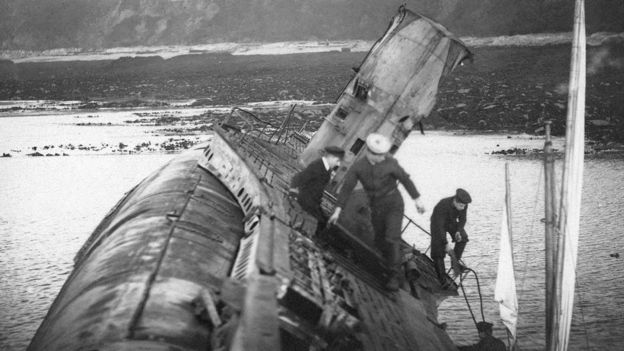Previously unseen pictures of German submarines stranded on the English coast have been released to mark the centenary of a wartime turning point.
A hundred years ago during World War One, Germany declared unrestricted submarine warfare and started targeting hundreds of ships without warning.
The submarines shown were surrendered by Germany at the end of the war and sank off the coast of Cornwall.
Pictures of WW1 submarines stranded on English coast revealed
1 February 2017
BBC News

The number of British ships destroyed by U-boats nearly tripled after Germany declared unrestricted submarine warfare
Previously unseen pictures of German submarines stranded on the English coast have been released to mark the centenary of a wartime turning point.
A hundred years ago during World War One, Germany declared unrestricted submarine warfare and started targeting hundreds of ships without warning.
The submarines shown were surrendered by Germany at the end of the war and sank off the coast of Cornwall.
The images from 1921 have been donated to Historic England.

The submarines had already been surrendered by the Germans, but sank while being towed by British ships

The targeting of supply ships without warning outraged the world, and ultimately brought the United States into World War One
The German submarines - known as U-boats - wrecked on the Cornish coast in Falmouth and some remains can still be seen.
German forces surrendered the submarines in 1918 and, having been stripped of their engines, they became difficult to tow and occasionally sank or became wrecked on British beaches.

Two of the U-boats - such as this one at Castle Beach in Falmouth - can still be seen at low water
In the year before unrestricted submarine warfare was declared by Germany, 431 ships were sunk by U-boats worldwide.
The following year, that number reached 1,263.
Roger Bowdler, from Historic England, said the declaration was "a decisive moment" in World War One.
He said: "It was seen as uncivilised, ungentlemanly and ultimately brought the might of the United States into the war."
The pictures were taken by naval officer Jack Casement and donated to the Historic England Archive by his family.

The National Submarine War Memorial commemorates the lives of those who died as part of the Submarine Service
One third of the Submarine Service's total personnel died during World War One, the highest proportion of any branch of the armed services.
To commemorate their lives, the National Submarine War Memorial was unveiled in 1922, at Temple Pier on the Thames in London.
The memorial has now been upgraded to Grade II* listed status, which means it has an "above-average level of special interest".

The memorial - unveiled in 1922 - shows a cross-section of a submarine
Pictures of WW1 submarines stranded on English coast revealed - BBC News
A hundred years ago during World War One, Germany declared unrestricted submarine warfare and started targeting hundreds of ships without warning.
The submarines shown were surrendered by Germany at the end of the war and sank off the coast of Cornwall.
Pictures of WW1 submarines stranded on English coast revealed
1 February 2017
BBC News

The number of British ships destroyed by U-boats nearly tripled after Germany declared unrestricted submarine warfare
Previously unseen pictures of German submarines stranded on the English coast have been released to mark the centenary of a wartime turning point.
A hundred years ago during World War One, Germany declared unrestricted submarine warfare and started targeting hundreds of ships without warning.
The submarines shown were surrendered by Germany at the end of the war and sank off the coast of Cornwall.
The images from 1921 have been donated to Historic England.

The submarines had already been surrendered by the Germans, but sank while being towed by British ships

The targeting of supply ships without warning outraged the world, and ultimately brought the United States into World War One
The German submarines - known as U-boats - wrecked on the Cornish coast in Falmouth and some remains can still be seen.
German forces surrendered the submarines in 1918 and, having been stripped of their engines, they became difficult to tow and occasionally sank or became wrecked on British beaches.

Two of the U-boats - such as this one at Castle Beach in Falmouth - can still be seen at low water
In the year before unrestricted submarine warfare was declared by Germany, 431 ships were sunk by U-boats worldwide.
The following year, that number reached 1,263.
Roger Bowdler, from Historic England, said the declaration was "a decisive moment" in World War One.
He said: "It was seen as uncivilised, ungentlemanly and ultimately brought the might of the United States into the war."
The pictures were taken by naval officer Jack Casement and donated to the Historic England Archive by his family.

The National Submarine War Memorial commemorates the lives of those who died as part of the Submarine Service
One third of the Submarine Service's total personnel died during World War One, the highest proportion of any branch of the armed services.
To commemorate their lives, the National Submarine War Memorial was unveiled in 1922, at Temple Pier on the Thames in London.
The memorial has now been upgraded to Grade II* listed status, which means it has an "above-average level of special interest".

The memorial - unveiled in 1922 - shows a cross-section of a submarine
Pictures of WW1 submarines stranded on English coast revealed - BBC News